2000 BMW 328Ci COUPE light
[x] Cancel search: lightPage 13 of 189

11n
Controls and features
Operation, care and maintenance
Lamps:
Parking lamps/Headlamps84
Instrument panel rheostat84
High beams/Parking lamps85
Fog lamps85
Interior lamps85
Reading lamps86
Controlling the climate
for pleasant driving:
Automatic climate control88
Heated seats93
Roller sun blind93
Cabin convenience:
HiFi System94
Glove compartment94
Storage compartments95
Cellular phones95
Ashtray96
Cigarette lighter96
Clothes hooks97
Loading and transporting:
Through-loading facility98
Ski bag99
Cargo loading100
Roof-mounted luggage rack101
Special operating instructions:
Break-in procedures104
Driving notes104
Catalytic converter105
Antilock Brake System
(ABS)106
Disc brakes108
Brake system109
Winter operation110
Power steering112
Cellular phones112
Radio reception112
Wheels and tires:
Tire inflation pressures113
Tire condition113
Tire replacement114
Tire rotation114
Wheel and tire
combinations115
Winter tires116
Snow chains116
Approved wheel and tire
specifications117
Under the hood:
Hood119
Engine compartment120
Washer fluids122
Washer nozzles122
Engine oil123
Coolant126
Brake fluid127
Vehicle Identification
Number128
Care and maintenance:
The BMW Maintenance
System129
Caring for your car130
Airbags135
Vehicle storage136
Laws and regulations:
Technical modifications
to the vehicle136
OBD connector137
Page 19 of 189
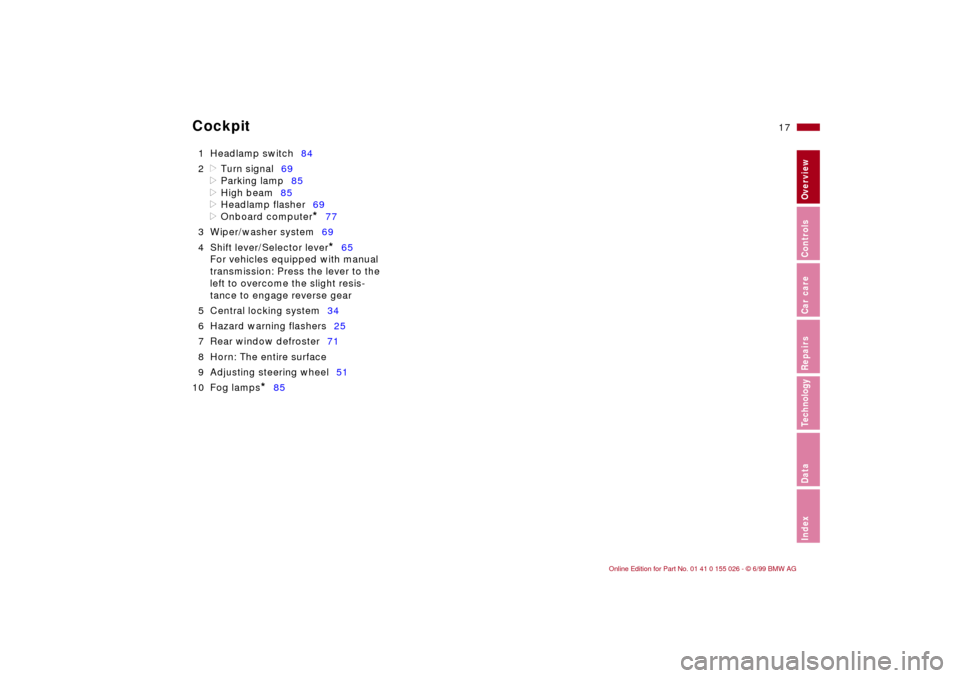
17n
RepairsIndexOverview Controls Car care Technology Data
Cockpit
1 Headlamp switch84
2
d
Turn signal69
>
Parking lamp85
>
High beam85
>
Headlamp flasher69
>
Onboard computer
*
77
3 Wiper/washer system69
4 Shift lever/Selector lever
*
65
For vehicles equipped with manual
transmission: Press the lever to the
left to overcome the slight resis-
tance to engage reverse gear
5 Central locking system34
6 Hazard warning flashers25
7 Rear window defroster71
8 Horn: The entire surface
9 Adjusting steering wheel51
10 Fog lamps
*
85
Page 22 of 189
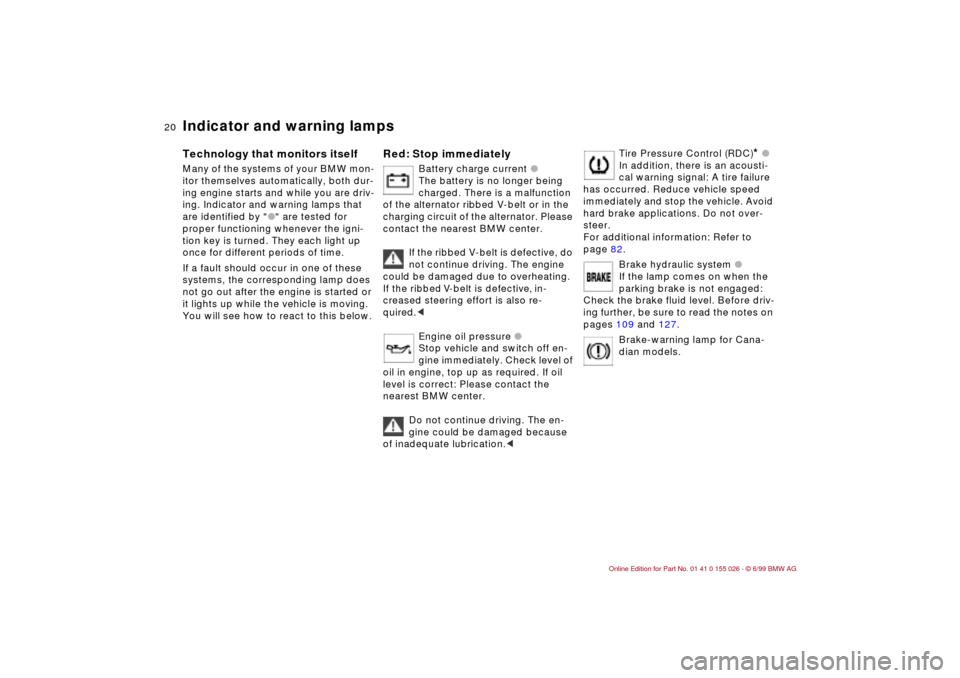
20n
Indicator and warning lamps
Technology that monitors itself
Many of the systems of your BMW mon-
itor themselves automatically, both dur-
ing engine starts and while you are driv-
ing. Indicator and warning lamps that
are identified by "
l
" are tested for
proper functioning whenever the igni-
tion key is turned. They each light up
once for different periods of time.
If a fault should occur in one of these
systems, the corresponding lamp does
not go out after the engine is started or
it lights up while the vehicle is moving.
You will see how to react to this below.
Red: Stop immediately
Battery charge current
l
The battery is no longer being
charged. There is a malfunction
of the alternator ribbed V-belt or in the
charging circuit of the alternator. Please
contact the nearest BMW center.
If the ribbed V-belt is defective, do
not continue driving. The engine
could be damaged due to overheating.
If the ribbed V-belt is defective, in-
creased steering effort is also re-
quired.
<
Engine oil pressure
l
Stop vehicle and switch off en-
gine immediately. Check level of
oil in engine, top up as required. If oil
level is correct: Please contact the
nearest BMW center.
Do not continue driving. The en-
gine could be damaged because
of inadequate lubrication.
<
Tire Pressure Control (RDC)
* l
In addition, there is an acousti-
cal warning signal: A tire failure
has occurred. Reduce vehicle speed
immediately and stop the vehicle. Avoid
hard brake applications. Do not over-
steer.
For additional information: Refer to
page 82.
Brake hydraulic system l
If the lamp comes on when the
parking brake is not engaged:
Check the brake fluid level. Before driv-
ing further, be sure to read the notes on
pages 109 and 127.
Brake-warning lamp for Cana-
dian models.
Page 23 of 189
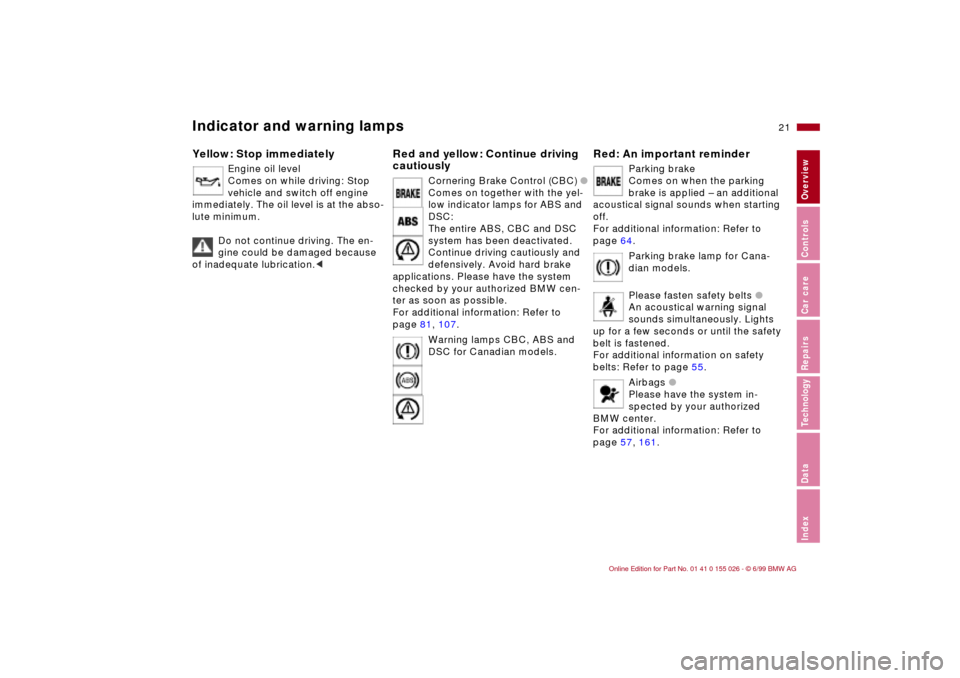
21n
RepairsIndexOverview Controls Car care Technology Data
Indicator and warning lampsYellow: Stop immediately
Engine oil level
Comes on while driving: Stop
vehicle and switch off engine
immediately. The oil level is at the abso-
lute minimum.
Do not continue driving. The en-
gine could be damaged because
of inadequate lubrication.<
Red and yellow: Continue driving
cautiously
Cornering Brake Control (CBC) l
Comes on together with the yel-
low indicator lamps for ABS and
DSC:
The entire ABS, CBC and DSC
system has been deactivated.
Continue driving cautiously and
defensively. Avoid hard brake
applications. Please have the system
checked by your authorized BMW cen-
ter as soon as possible.
For additional information: Refer to
page 81, 107.
Warning lamps CBC, ABS and
DSC for Canadian models.
Red: An important reminder
Parking brake
Comes on when the parking
brake is applied – an additional
acoustical signal sounds when starting
off.
For additional information: Refer to
page 64.
Parking brake lamp for Cana-
dian models.
Please fasten safety belts l
An acoustical warning signal
sounds simultaneously. Lights
up for a few seconds or until the safety
belt is fastened.
For additional information on safety
belts: Refer to page 55.
Airbags l
Please have the system in-
spected by your authorized
BMW center.
For additional information: Refer to
page 57, 161.
Page 25 of 189
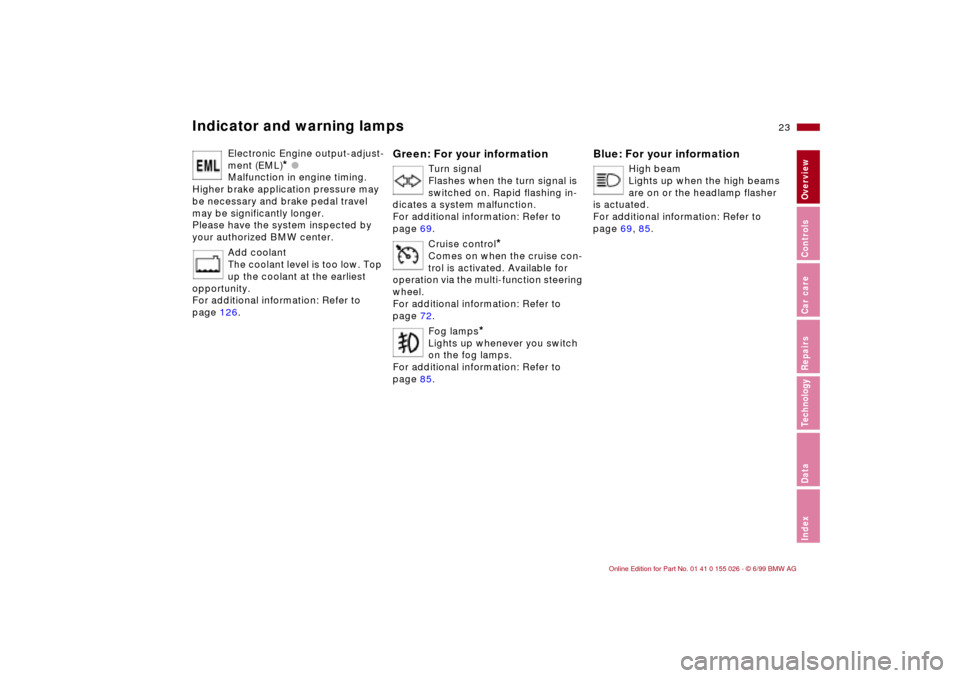
23n
RepairsIndexOverview Controls Car care Technology Data
Indicator and warning lamps
Electronic Engine output-adjust-
ment (EML)
* l
Malfunction in engine timing.
Higher brake application pressure may
be necessary and brake pedal travel
may be significantly longer.
Please have the system inspected by
your authorized BMW center.
Add coolant
The coolant level is too low. Top
up the coolant at the earliest
opportunity.
For additional information: Refer to
page 126.
Green: For your information
Turn signal
Flashes when the turn signal is
switched on. Rapid flashing in-
dicates a system malfunction.
For additional information: Refer to
page 69.
Cruise control
*
Comes on when the cruise con-
trol is activated. Available for
operation via the multi-function steering
wheel.
For additional information: Refer to
page 72.
Fog lamps
*
Lights up whenever you switch
on the fog lamps.
For additional information: Refer to
page 85.
Blue: For your information
High beam
Lights up when the high beams
are on or the headlamp flasher
is actuated.
For additional information: Refer to
page 69, 85.
Page 33 of 189

Overview
Controls and features
Operation, care
and maintenance
Owner service procedures
Technical data
Index Advanced technology
31n
RepairsIndexOverview Controls Car care Technology Data
Manual transmission65
Automatic transmission with
Steptronic66
Turn signal/Headlamp flasher69
Wiper/washer system/Rain
sensor69
Rear window defroster71
Cruise control72
Everything under control:
Odometer74
Tachometer74
Energy control74
Fuel gauge75
Temperature gauge75
Service Interval Display76
Check Control77
Clock77
Onboard computer77
Technology for safety and
convenience:
Park Distance Control (PDC)80
Dynamic Stability Control
(DSC)81
Tire Pressure Control (RDC)82Lamps:
Parking lamps/Headlamps84
Instrument panel rheostat84
High beams/Parking lamps85
Fog lamps85
Interior lamps85
Reading lamps86
Controlling the climate
for pleasant driving:
Automatic climate control88
Heated seats93
Roller sun blind93
Cabin convenience:
HiFi System94
Glove compartment94
Storage compartments95
Cellular phones95
Ashtray96
Cigarette lighter96
Clothes hooks97
Loading and transporting:
Through-loading facility98
Ski bag99
Cargo loading100
Roof-mounted luggage rack101
Page 37 of 189
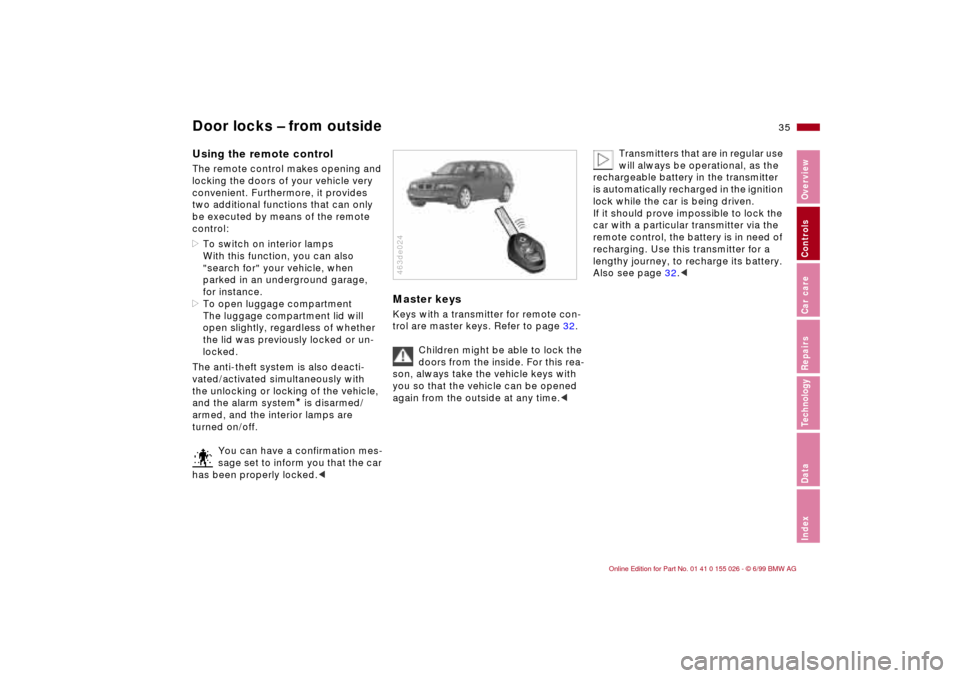
35n
RepairsIndexOverview Controls Car care Technology Data
Door locks – from outsideUsing the remote control The remote control makes opening and
locking the doors of your vehicle very
convenient. Furthermore, it provides
two additional functions that can only
be executed by means of the remote
control:
>To switch on interior lamps
With this function, you can also
"search for" your vehicle, when
parked in an underground garage,
for instance.
>To open luggage compartment
The luggage compartment lid will
open slightly, regardless of whether
the lid was previously locked or un-
locked.
The anti-theft system is also deacti-
vated/activated simultaneously with
the unlocking or locking of the vehicle,
and the alarm system
* is disarmed/
armed, and the interior lamps are
turned on/off.
You can have a confirmation mes-
sage set to inform you that the car
has been properly locked.<
Master keysKeys with a transmitter for remote con-
trol are master keys. Refer to page 32.
Children might be able to lock the
doors from the inside. For this rea-
son, always take the vehicle keys with
you so that the vehicle can be opened
again from the outside at any time.<463de024
Transmitters that are in regular use
will always be operational, as the
rechargeable battery in the transmitter
is automatically recharged in the ignition
lock while the car is being driven.
If it should prove impossible to lock the
car with a particular transmitter via the
remote control, the battery is in need of
recharging. Use this transmitter for a
lengthy journey, to recharge its battery.
Also see page 32.<
Page 39 of 189
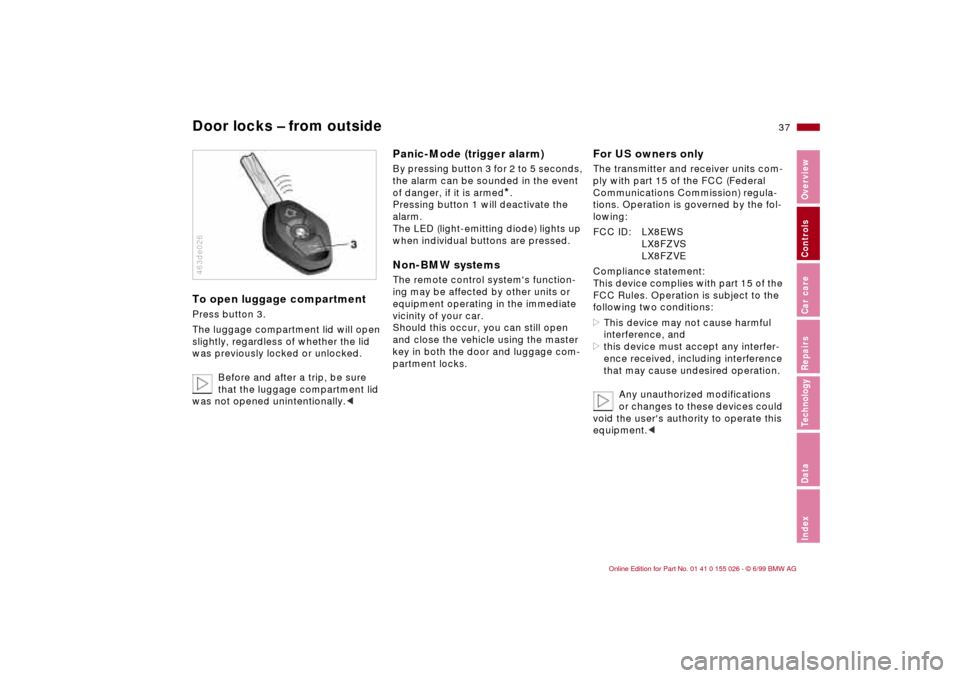
37n
RepairsIndexOverview Controls Car care Technology Data
Door locks – from outsideTo open luggage compartmentPress button 3.
The luggage compartment lid will open
slightly, regardless of whether the lid
was previously locked or unlocked.
Before and after a trip, be sure
that the luggage compartment lid
was not opened unintentionally.<463de026
Panic-Mode (trigger alarm)By pressing button 3 for 2 to 5 seconds,
the alarm can be sounded in the event
of danger, if it is armed
*.
Pressing button 1 will deactivate the
alarm.
The LED (light-emitting diode) lights up
when individual buttons are pressed.
Non-BMW systemsThe remote control system's function-
ing may be affected by other units or
equipment operating in the immediate
vicinity of your car.
Should this occur, you can still open
and close the vehicle using the master
key in both the door and luggage com-
partment locks.
For US owners onlyThe transmitter and receiver units com-
ply with part 15 of the FCC (Federal
Communications Commission) regula-
tions. Operation is governed by the fol-
lowing:
FCC ID: LX8EWS
LX8FZVS
LX8FZVE
Compliance statement:
This device complies with part 15 of the
FCC Rules. Operation is subject to the
following two conditions:
>This device may not cause harmful
interference, and
>this device must accept any interfer-
ence received, including interference
that may cause undesired operation.
Any unauthorized modifications
or changes to these devices could
void the user's authority to operate this
equipment.<